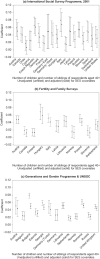Cross-national patterns of intergenerational continuities in childbearing in developed countries
- PMID: 24215254
- PMCID: PMC4160295
- DOI: 10.1080/19485565.2013.833779
Cross-national patterns of intergenerational continuities in childbearing in developed countries
Abstract
Earlier work has shown that the association between the fertility of parents and the fertility of children has become stronger over time in some societies. This article updates and broadens the geographic coverage to assess the magnitude of intergenerational continuities in childbearing in developed and middle-income societies using data for 46 populations from 28 developed countries drawn from a number of recent large-scale survey programs. Robust positive intergenerational fertility correlations are found across these countries into the most recent period, and although there is no indication that the strength of the relationship is declining, the increasing trend does not appear to be continuing.
Figures



Similar articles
-
Is the Family Size of Parents and Children Still Related? Revisiting the Cross-Generational Relationship Over the Last Century.Demography. 2019 Apr;56(2):595-619. doi: 10.1007/s13524-019-00767-5. Demography. 2019. PMID: 30868472 Free PMC article.
-
Intergenerational fertility correlations in contemporary developing counties.Am J Hum Biol. 2012 Sep-Oct;24(5):696-704. doi: 10.1002/ajhb.22300. Epub 2012 Jul 17. Am J Hum Biol. 2012. PMID: 22807035
-
Intergenerational effects on fertility: theory and evidence from Israel.J Popul Econ. 1989;2(1):25-37. doi: 10.1007/BF00599178. J Popul Econ. 1989. PMID: 12315946
-
Residual confounding explains the association between high parity and child mortality.BMC Public Health. 2013;13 Suppl 3(Suppl 3):S5. doi: 10.1186/1471-2458-13-S3-S5. Epub 2013 Sep 17. BMC Public Health. 2013. PMID: 24564642 Free PMC article. Review.
-
Is the relationship between fertility of parents and children really weak?Soc Biol. 1999 Spring-Summer;46(1-2):122-45. doi: 10.1080/19485565.1999.9988991. Soc Biol. 1999. PMID: 10842505 Review.
Cited by
-
Preferences for a mixed-sex composition of offspring: A multigenerational approach.Popul Stud (Camb). 2022 Mar;76(1):1-18. doi: 10.1080/00324728.2022.2027003. Epub 2022 Feb 8. Popul Stud (Camb). 2022. PMID: 35132940 Free PMC article.
-
Maternal age at birth and daughter's fecundability.Hum Reprod. 2021 Jun 18;36(7):1970-1980. doi: 10.1093/humrep/deab057. Hum Reprod. 2021. PMID: 33860312 Free PMC article.
-
How Does Birth Order and Number of Siblings Affect Fertility? A Within-Family Comparison Using Swedish Register Data.Eur J Popul. 2019 Apr 30;36(2):197-233. doi: 10.1007/s10680-019-09525-0. eCollection 2020 Apr. Eur J Popul. 2019. PMID: 32256257 Free PMC article.
-
Is the Family Size of Parents and Children Still Related? Revisiting the Cross-Generational Relationship Over the Last Century.Demography. 2019 Apr;56(2):595-619. doi: 10.1007/s13524-019-00767-5. Demography. 2019. PMID: 30868472 Free PMC article.
-
Is Educating Girls the Best Investment for South Asia? Association Between Female Education and Fertility Choices in South Asia: A Systematic Review of the Literature.Front Public Health. 2018 Jul 13;6:172. doi: 10.3389/fpubh.2018.00172. eCollection 2018. Front Public Health. 2018. PMID: 30057895 Free PMC article.
References
-
- Anderton D. L., Tsuya N. O., Bean L. L., Mineau D. G. P. Intergenerational transmission of relative fertility and life course patterns. Demography. 1987;24:467–480. - PubMed
-
- Balbo N., Mills M. The influence of the family network on the realisation of fertility intentions. In: Philip Morgan S. Sobotka T. Testa M. R. , editor. Vienna yearbook of population research. Vol. 9. Vienna: Verlag der Österreichischen Akademie der Wissenschaften; 2011. pp. 179–206.
-
- Barber J. S. Intergenerational influences on the entry into parenthood: Mothers' preferences for family and nonfamily behavior. Soc Forces. 2000;79:319–348.
-
- Barber J. S. The intergenerational transmission of age at first birth among married and unmarried men and women. Soc Sci Res. 2001;30(2):219–247.
MeSH terms
LinkOut - more resources
Full Text Sources
Other Literature Sources

